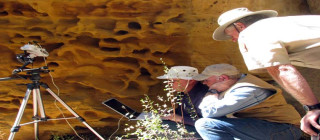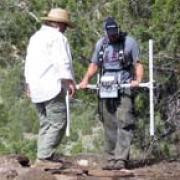Range Creek Archaeology & Technological Advances

We live in an age of ever increasing technological advancement. Archaeologists are keenly aware of this and routinely advocate for the preservation of large portions of sites for future investigations. Listed below are some of the most recent technological advancements and how they are being applied in Range Creek Canyon.
XRF and Rock Art
X-ray flouresence (XRF) technology is based on the principle that materials exposed to high energy X-rays will emit secondary "flourescent" rays and each chemical element emits secondary rays with unique signatures. XRF technology is particularly useful in archaeology because the process is non-destructive. In the fall of 2008 Physicist Bruce Kaiser, Brueker AXS Inc. at the invitation of RCRP Project Director Duncan Metcalfe spent the day traveling to rock art panels in Range Creek. Using a Brueker hand held XRF they tested pigments of different colors in an attempt to identify the composition of the paints.
Magnatometer

July 29, 2008 a new PBS program Time Team America will air Episode 4 filmed in Range Creek Canyon. Along with film, video and archaeological crews they brought with them researchers Meg Watters and Bryan Haley armed with magnatoneters. Magnatometers detect anomalies produced by heat, fire, and iron-rich objects or geologic deposits beneath the surface of the ground. Humans use fire to such an extent that this method is ideally suited for exploring archaeological sites. Magnetometer data can be used by archaeologists to "see" below the surface of the ground to locate buried hearths, burned houses and trash heaps. This is extremly useful when deciding where excavation units should be placed or how large and complex a particular site might be.
3-D Laser Scanning
Ken Mears of M2 resources visited Range Creek in the summer of 2008 to scan rock art panels and rubble mounds. 3-D laser scanners emit trillions of photons at an object and collect distance, height and width information from those (photons) that are reflected back to the data logger. Archaeological applications of 3-D laser technology is used to produce accurate digital three dimensional images of object as diverse as artifacts, ruins, and/or rock art panels. Data from multiple passes from many different angles compiled to produce a "point cloud" of the object or feature that is being investigated. Scientists must consider the properties of the object to devise the strategy that will best accomplish their goals. Color and luster of an object effect the outcome. Analogous to sunlight on a summer day light objects reflect rays (photons) where darker objects tend to absorb them and shinny or transparent objects reflect or refract the light (photons) in an unpredictable manner leading to false readings.